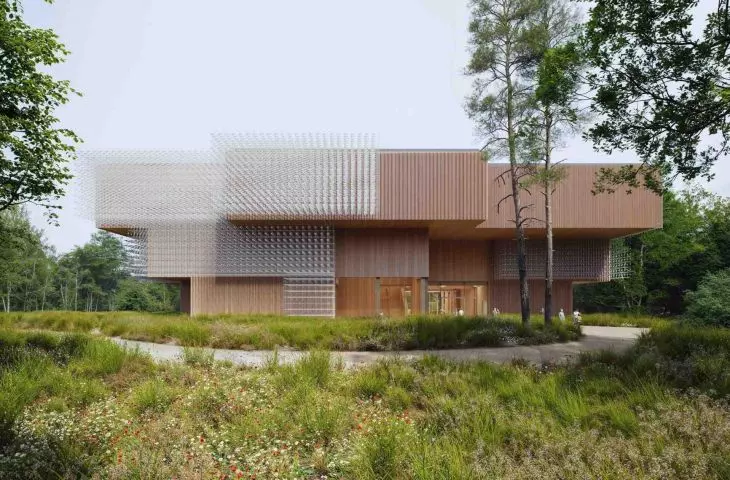Xylopolis: Center for Art and Science of Wood is a new investment of Podlaskie Voivodeship, whose intriguing headquarters, located in Wasilkow, will be completed in 2027. However, we are already introducing the rich history leading to the establishment of the institution and presenting its building, the design of which is the responsibility of the Warsaw architectural studio WXCA.
The road to Xylopolis
The beginnings of Xylopolis are connected with the organization of the Polish Pavilion, presented at EXPO 2020 in Dubai. The building and the inextricably linked exhibition were dedicated to wood as a raw material in which Polish craftsmanship, art and engineering thought find expression for the idea of sustainable development. In response to one of the assigned topics - mobility - the architects of WXCA – pracownia architektoniczna decided to design a pavilion building made largely of this very material. The proposed building with a modular structure, suitable for lossless demolition and subsequent reassembly and adaptation to serve a new function, became an exemplary example of sustainable architecture of a circular nature. In the words of the project's lead author, Marta Sekulska-Wronska, Xylopolis is not so much an exhibition or a building, but rather a story that, as we can see, continues to this day. Its extension will now become the Xylopolis Wood Art and Science Center.
Xylopolis Wood Art and Science Center - visualization of the Hall
© WXCA
new headquarters
Due to the different climatic characteristics of Dubai and the legal conditions, which are different from those in Poland, the entities responsible for organizing the construction of the Podlasie Center decided on the need to design a new building, which will be the next chapter of the story, having its beginnings at EXPO 2020. As in the case of the Pavilion, the WXCA studio is responsible for the concept, which decided to propose a building based on the assumptions known from the Dubai exhibition. Analogous to the original, Wasilkow's Xylopolis will be made largely of wood, which will find its use not only as the theme of the exhibition, but also as a building material, implemented in the structural elements, facade and interior cladding. The center's geometrized body, supported by three massive pillars, is filled with symbolism - the aforementioned pillars, in addition to serving as vertical passageways, are to be associated by visitors with three spreading trees. The kinetic sculpture decorating the façade, in addition to supporting the building's HVAC systems, in turn evokes associations with the phenomenon of murmuring birds, which, joining together in large flocks, perform spectacular skyward maneuvers. The moving nature of the sculpture, which changes its form thanks to gusts of wind hitting it, reminds us of the physical aspects of energy management inside the building, implemented with passive heat and lighting management solutions.
Visualization of the concept for the development of the area around the Xylopolis Center for the Arts and Science of Wood
© WXCA
forest of possibilities
Perhaps the most significant change for visitors, however, is the volume of Xylopolis, which, unlike the Polish Pavilion, will offer not 2, but as much as 6,000 square meters of floor space. The consequence of this change will primarily be a significant modification of the exhibition program and the numerous attractions offered by the Center. Xylopolis will be divided into three main sections, apparently corresponding to the three aforementioned pillars on which the building is supported. The first of these will be the Hall, the concept of which is expected to correspond to the greatest extent to what visitors had the opportunity to see at the EXPO. As part of an exhibition telling the story of wood in Polish craftsmanship, art and engineering, it will include the Polish Table, made by an interdisciplinary team, and a composition painted by Leon Tarasewicz, with unmistakably "forest" overtones. The second functional zone of Xylopolis is to become the Agora of Nature, which will serve as a space for dialogue, equipped with a discussion room and auditorium. But the most interesting is the last of the sections, called "Craft Culture," which will include craft and workshop spaces equipped with specialized equipment, enabling those interested and employed at the Center to work together on wood, exchange experiences and participate in events. Writing about the Xylopolis program, it is also impossible not to mention the concept of developing the space around the Center - within the Xylopolis Archipelago an amphitheater, an Art Park and thematic gardens will be arranged, presenting the biomes found in Polish forests. The most spectacular element of the Archipelago may become a viewing tower, which will allow visitors to admire the open-air museum of wooden architecture, which is part of the Museum of Podlasie Folk Culture located on the same plot, with which, by the way, Xylopolis will conduct close cooperation. We will be able to enjoy the fruits of this cooperation, as well as all the other entities involved in the creation of Xylopolis, in 2027, when the Center for the Arts and Science of Wood is scheduled to open.































